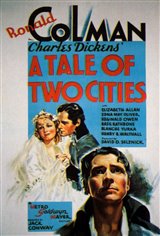A Tale of Two Cities
It is a tale known well, filmed many times over the years, but never better than this early black and white version from the MGM Studios, David O. Selznick producing. It was the best of times, it was the worst of times-- Charles Dickens juxtaposes England and France, George and Louis, tradition and revolution.
One of the most beloved of Dickens' stories, finding not only countries and conditions compared, but also two individuals thrown up in stark contrast to one another: -- the dissolute barrister Sydney Carton (Ronald Colman) and the young, somewhat callow aristocrat Charles Darnay (Donald Woods), both in love with Lucie (Elizabeth Allan), daughter of a victim of the French Regime.
Their lives intertwine until the violent revolution that overtook an entire nation engulfs them all as well.Dickens' story has stood the test of time; remade frequently since the release of this1935 version. It is this version by director Jack Conway's that is best remembered and to which all others are compared.
The settings, cinematography, and direction are all right on the mark, recreating the streets of London and of Paris with great skill and realism.
The supporting cast, filled with faces we have grown to cherish-- Reginald Owen, Edna May Oliver, Claude Gillingwater, Walter Catlett, H. B. Warner, Basil Rathbone, and E. E. Clive-comes through with crystalline performances which add substance to the inexorable stream of events.
Blanche Yurka's bravura turn as Therese de Farge delights us even as we shudder at her intensity. Second unit directors Jacques Tourneur and Val Lewton, who would both go on to memorable careers as leading directors in their own right, staged the storming of the Bastille and other revolutionary scenes brilliantly, managing to combine fervor with panache.
It is, however, Colman's portrayal of the lonely man redeemed by love and sacrifice which stands at the center of the story.Sydney Carton first saves Charles Darnay from a charge of treason, thereby meeting those who care for him: the beautiful Lucie Manette, her father, Doctor Manette (Henry B. Walthall), released from the Bastille after many years of unjust incarceration; Lucie's servant Miss Pross, (Oliver) and Mister Lorry (Claude Gillingwater), an functionary of Tellson's Bank.
His relationship with this circle of kind friends grows rocky when Darnay marries Lucie, whom Carton has loved from afar, but even this turn of events cannot change his feelings for them all and he grows to love them even more when daughter Lucie comes along. He reforms, leaving old ways behind and enjoying a familial warmth he has never known.
This happy life is shattered when Darnay returns to France during the first revolutionary struggles, intent on saving his old tutor from the guillotine. He soon finds himself behind bars and facing the blade instead. The Revolution does not forget an aristocrat, even one who has recanted and lived life abroad as a commoner.
The whole family makes the channel crossing to come to the young man's aid and Carton seeks a way to save him, discovering only one path to free Darnay and return everyone to safety. It is a sacrifice easily promised and quickly made.
Ronald Colman had long wanted to make a film of this story and, when he finally got his chance, he happily shaved off his signature mustache in an appropriate gesture to historical realism.
Reviews of his work indicate his portrayal of Sydney Carton surpassed all his previous endeavors; he had been accused of walking through light parts, once he started making talkies, and not putting his many talents to good use. A Tale of Two Cities put rest to those complaints.
He dominates completely the scenes he which he does appear, and his skill gives substance to a literary achievement, a melancholy man of intelligence and wit, given to drink and despair, whose life seems to attain meaning only when it is given up for someone else.
It is one of the portrayals for which Ronald Colman has come to be remembered.There are various remake versions of A Tale of Two Cities.
Dirk Bogarde played Carton in 1958 and Chris Sarandon starred in a television remake in 1980. While these and other versions have all been good films, none has achieved the stature of the 1935 version and its excellent combination of star power, technical brilliance and great storytelling.

